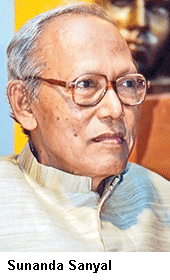 Public education and health, widely accepted as prerequisites of economic development, were grossly neglected during the 34-year uninterrupted rule of the CPM-led Left Front government (1977-2011) in West Bengal. The consequence is that the country’s then most industrially and academically advanced state transformed into the most backward following a massive — and continuing — flight of capital and professionals from the state.
Public education and health, widely accepted as prerequisites of economic development, were grossly neglected during the 34-year uninterrupted rule of the CPM-led Left Front government (1977-2011) in West Bengal. The consequence is that the country’s then most industrially and academically advanced state transformed into the most backward following a massive — and continuing — flight of capital and professionals from the state.
Unfortunately, incumbent chief minister Mamata Banerjee and the Trinamool Congress, which routed the CPM-led Left Front alliance in the assembly election of 2011 and again in 2016, haven’t made good their election promise to resurrect the education and health sectors in this benighted state (pop.91 million), which right until the mid-1970s was renowned for the high-quality education dispensed in its schools and universities.
Against this dismal backdrop, a Central government announcement of May 18 giving a green light to 17 new medical colleges in the government and private sectors — including five in West Bengal — has enthused the state’s shrinking middle class, particularly the bhadralok (refined middle class). Equally enthusiastic, the West Bengal University of Health Sciences, the statutory body for medical education in the state, is clearing the decks for increasing the number of seats available in the state’s 14 government medical colleges.
Currently, there are a mere 2,600 seats in West Bengal’s 22 medical and dental colleges (including the 14 promoted and managed by the state government), one run by the West Bengal University of Health Sciences and seven private medical colleges. Therefore, news of increased capacity for medical education has been widely welcomed by academics and the state’s medical fraternity.
Meanwhile, construction of five new medical colleges in Diamond Harbour of South 24 Parganas, Raiganj of Uttar Dinajpur, Rampurhat of Birbhum, Purulia and Cooch Behar districts — approved in 2018 — is going on full swing, to enable them to start operations in 2019. These new colleges will add 700 MBBS seats to the existing capacity of government and private medical colleges statewide. Two other medical colleges in Jalpaiguri district and Arambagh in Hooghly district, are also set to admit their first batches next year.
But, even as the state government maintains that the decks of five hospitals in the state have been cleared for them to start medical colleges, and MCI has clarified its guidelines stipulating the minimum infrastructure required, a 2016 report of Students’ Federation of India (West Bengal State Committee) states that none of the medical colleges in West Bengal meets these norms.
While within the state government, academia and medical fraternity there is an air of celebration and euphoria over these minuscule additions to medical education capacity, building, upgradation of extant hospitals and clearance given to the establishment of five greenfield teaching hospitals, prescient monitors of West Bengal’s economy express amazement at the scale of neglect of medical education and care in this once prosperous state of the Indian Union. The doctor-population ratio of West Bengal at 61 per 100,000 is among the lowest worldwide as is the hospital beds to population ratio at 86 per 100,000. These ratios are abysmal not only in comparison with developed countries but also with neighbouring Asian countries including Indonesia, Malaysia and even Bangladesh.
“The CPM (Communist Party-Marxist)-led Left Front government, which ruled in West Bengal for 34 years, promised to provide poorest people the basic facilities of elementary education and health services. Instead, as these ratios indicate, they frittered away the substantial tax revenue and completely impoverished Bengal.
Shockingly, the academy and intelligentsia of West Bengal continue to sympathise with the CPM. It’s an indicator of their intellectual poverty,” says Sunanda Sanyal, a renowned educationist sympathetic to the ruling TMC government.
But now in its second term in office, the TMC needs to stop looking back in anger and urgently upgrade the state’s long-neglected education and health sectors.
Baishali Mukherjee (Kolkata)